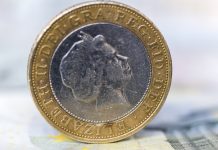Escalating trade tensions and analysts’ predictions of a weaker UK inflation print, kept the pound US dollar evenly matched on Tuesday. The pound US dollar exchange rate traded a range of 100 points but ended the session at US$1.3148, roughly the same level that it started.
| What do these figures mean? |
|---|
|
When measuring the value of a pair of currencies, one set equals 1 unit and the other shows the current equivalent. As the market moves, the amount will vary from minute to minute. For example, it could be written: 1 GBP = 1.28934 USD Here, £1 is equivalent to approximately $1.29. This specifically measures the pound’s worth against the dollar. If the US dollar amount increases in this pairing, it’s positive for the pound. Or, if you were looking at it the other way around: 1 USD = 0.77786 GBP In this example, $1 is equivalent to approximately £0.78. This measures the US dollar’s worth versus the British pound. If the sterling number gets larger, it’s good news for the dollar. |
The pound has had a reasonably quiet start to the week. Market participants are now preparing for an increase of volatility in the pound as it heads towards the end of the week. The UK economic calendar has so far been quiet, leaving pound traders focused on Brexit developments. Brexit headlines have also had a softer tone from the EU, providing some optimism heading towards the Salzburg summit.
Investors are hoping to see a continued softening to Brussels’ stance, with Britain calling for the EU to be more flexible in its approach to Brexit, particularly to the Irish border issue. This remains a key issue and one that investors are keen to see progress as the deadline for a Brexit deal looms closer.
| Why is a “soft” Brexit better for sterling than a “hard” Brexit? |
|---|
| A soft Brexit implies anything less than UK’s complete withdrawal from the EU. For example, it could mean the UK retains some form of membership to the European Union single market in exchange for some free movement of people, i.e. immigration. This is considered more positive than a “hard” Brexit, which is a full severance from the EU. The reason “soft” is considered more pound-friendly is because the economic impact would be lower. If there is less negative impact on the economy, foreign investors will continue to invest in the UK. As investment requires local currency, this increased demand for the pound then boosts its value. |
In addition to Brexit, investors will also be paying close attention to UK inflation figures. Analysts are expecting the UK Consumer price index (CPI) to tick lower in August to 2.4%, down from 2.5% in July, as it continues towards the BoE’s 2% target. Meanwhile analysts believe that core inflation, which strips out more volatile figures from food and fuel, with tick down to 1.8% in August from 1.9% the previous month. Should inflation print weaker, the pound could fall.
| Why does poor economic data drag on a country’s currency? |
|---|
| Slowing economic indicators point to a slowing economy. Weak economies have weaker currencies because institutions look to reduce investments in countries where growth prospects are low and then transfer money to countries with higher growth prospects. These institutions sell out of their investment and the local currency, thus increasing supply of the currency and pushing down the money’s worth. So, when a country or region has poor economic news, the value of the currency tends to fall. |
Dollar Mixed As Trade War Escalates
The dollar experienced volatility in the previous session as investors digested recent developments in the US — Sino trade war. The White House announced 10% tariffs on $200 billion of Chinese imports, earlier in the week. China retaliated in the previous session by slapping duties on $60 billion worth of US imports and opted against sending Chinese officials to Washington to continue with trade talks.
Today investors will continue watching trade tensions, however US housing data could also move the greenback. Analysts are expecting housing starts to have jumped to 5.7% month on month, significantly higher than the 0.9% increase in July. Strong data could help lift the dollar which has struggled under the pressure of escalating trade tensions.
This publication is provided for general information purposes only and is not intended to cover every aspect of the topics with which it deals. It is not intended to amount to advice on which you should rely. You must obtain professional or specialist advice before taking, or refraining from, any action on the basis of the content in this publication. The information in this publication does not constitute legal, tax or other professional advice from TransferWise Inc., Currency Live or its affiliates. Prior results do not guarantee a similar outcome. We make no representations, warranties or guarantees, whether express or implied, that the content in the publication is accurate, complete or up to date. Consult our risk warning page for more details.
This article was initially published on TransferWise.com from the same author. The content at Currency Live is the sole opinion of the authors and in no way reflects the views of TransferWise Inc.





